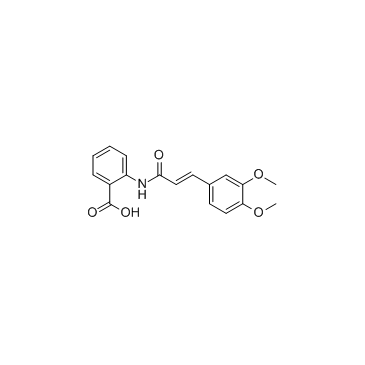Tranilast

Tranilast structure
|
Common Name | Tranilast | ||
|---|---|---|---|---|
| CAS Number | 53902-12-8 | Molecular Weight | 327.331 | |
| Density | 1.3±0.1 g/cm3 | Boiling Point | 585.5±50.0 °C at 760 mmHg | |
| Molecular Formula | C18H17NO5 | Melting Point | 166-168ºC | |
| MSDS | Chinese USA | Flash Point | 307.9±30.1 °C | |
| Symbol |

GHS07 |
Signal Word | Warning | |
|
Osmosensation in TRPV2 dominant negative expressing skeletal muscle fibres.
J. Physiol. 593 , 3849-63, (2015) Increased plasma osmolarity induces intracellular water depletion and cell shrinkage (CS) followed by activation of a regulatory volume increase (RVI). In skeletal muscle, the hyperosmotic shock-induced CS is accompanied by a small membrane depolarization res... |
|
|
Collagen density regulates xenobiotic and hypoxic response of mammary epithelial cells.
Environ. Toxicol. Pharmacol. 39(1) , 114-24, (2015) Breast density, where collagen I is the dominant component, is a significant breast cancer risk factor. Cell surface integrins interact with collagen, activate focal adhesion kinase (FAK), and downstream cell signals associated with xenobiotics (AhR, ARNT) an... |
|
|
Inhibitory Effect of Tranilast on Transforming Growth Factor-Beta-Induced Protein in Granular Corneal Dystrophy Type 2 Corneal Fibroblasts.
Cornea 34 , 950-8, (2015) To investigate the effects of tranilast, an inhibitor of chemical mediators and fibroblast proliferation, on the expression of transforming growth factor-beta (TGF-β)-induced protein (TGFBIp) in wild-type (WT) and homozygous (HO) granular corneal dystrophy ty... |
|
|
Dystrophic cardiomyopathy: role of TRPV2 channels in stretch-induced cell damage.
Cardiovasc. Res. 106 , 153-62, (2015) Duchenne muscular dystrophy (DMD), a degenerative pathology of skeletal muscle, also induces cardiac failure and arrhythmias due to a mutation leading to the lack of the protein dystrophin. In cardiac cells, the subsarcolemmal localization of dystrophin is th... |
|
|
Tranilast, an orally active antiallergic compound, inhibits extracellular matrix production in human uterine leiomyoma and myometrial cells.
Fertil. Steril. 102(2) , 597-606, (2014) To determine the effect of tranilast (an antiallergic drug known to suppress fibrosis or to stabilize mast cells) on extracellular matrix production in human leiomyoma and myometrial cells.Laboratory study.University-affiliated laboratory.Seven premenopausal ... |
|
|
Tranilast inhibits the function of cancer-associated fibroblasts responsible for the induction of immune suppressor cell types.
Scand. J. Immunol. 80(6) , 408-16, (2014) Cancer-associated fibroblasts (CAFs) are the dominant stromal component in the tumour microenvironment (TME), playing critical roles in generation of pro-tumourigenic TME; however, their contribution to suppression of antitumour immune responses has not been ... |
|
|
Pharmacological inhibition of coronary restenosis: systemic and local approaches.
Expert Opin. Pharmacother. 15(15) , 2155-71, (2014) Percutaneous coronary intervention (PCI) with stent implantation has revolutionized the treatment of obstructive coronary artery disease. However, the main limitation of this therapy is stent failure, which is usually caused by in-stent restenosis.The aim of ... |
|
|
Cancer-associated fibroblast-targeted strategy enhances antitumor immune responses in dendritic cell-based vaccine.
Cancer Sci. 106(2) , 134-42, (2015) Given the close interaction between tumor cells and stromal cells in the tumor microenvironment (TME), TME-targeted strategies would be promising for developing integrated cancer immunotherapy. Cancer-associated fibroblasts (CAFs) are the dominant stromal com... |
|
|
Nanoparticle coating on the silane-modified surface of magnesium for local drug delivery and controlled corrosion.
J. Biomater. Appl. 30 , 651-61, (2016) In this study, we proposed a potential method for the preparation of a magnesium-based medical device for local drug delivery and controlled corrosion. A magnesium surface was modified with 3-aminopropyltrimethoxy silane, and the resulting surface was then co... |
|
|
The Effects of Tamoxifen in Combination with Tranilast on CXCL12-CXCR4 Axis and Invasion in Breast Cancer Cell Lines.
Iran. J. Pharm. Res. 13(2) , 683-93, (2014) It has been reported that CXCL12 binding to CXCR4 induces several intracellular signaling pathways, and enhances survival, proliferation, and migration of malignant cells. In the present study, we examined the effects of anti-estrogen tamoxifen and anti-aller... |